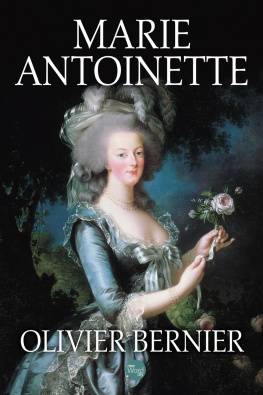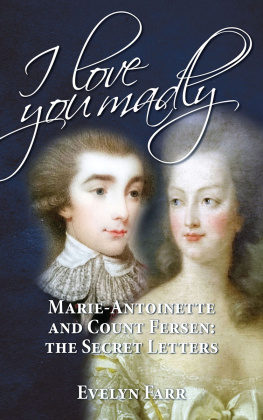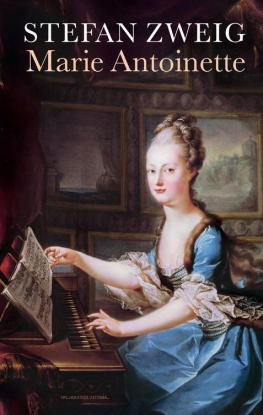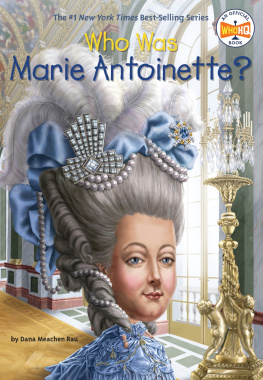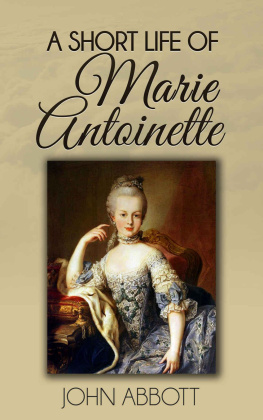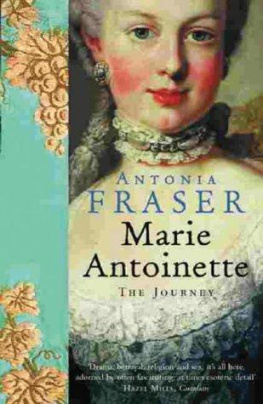MARIE-ANTOINETTE

Published with assistance from the Annie Burr Lewis Fund.
Copyright 2019 John Hardman
All rights reserved. This book may not be reproduced in whole or in part, in any form (beyond that copying permitted by Sections 107 and 108 of the U.S. Copyright Law and except by reviewers for the public press) without written permission from the publishers.
For information about this and other Yale University Press publications, please contact:
U.S. Office:
Europe Office:
Set in Minion Pro by IDSUK (DataConnection) Ltd
Great Britain by Gomer Press Ltd, Llandysul, Ceredigion, Wales
Library of Congress Control Number: 2019941055
ISBN 978-0-300-24308-6
A catalogue record for this book is available from the British Library.
10 9 8 7 6 5 4 3 2 1
This book is dedicated to those who helped me recover from serious injury, especially Gill Alcock, Mr Chris Armistead, Jane Hardman, Dr Meg Hardman, Dr Richard Hardman, Colonel Robert Hardman, Sheila Hardman, Joy Jones, Patrick Jones, Pam Lamb, Sheryl Millington, Jacqui Moore, Alan Peachment, Jane Platt, Professor Harry Procter, Jane Procter, Hazel Todhunter, Peter Todhunter and Barbara Wyatt.

CONTENTS

ILLUSTRATIONS

PRINCIPAL CHARACTERS
Some of the following classifications are somewhat schematic. There were overlaps: for instance, Marie-Antoinettes social group, the Polignacs, were also the kings political supporters often in opposition to the queen. I have placed Robespierre among the republicans but as late as 1791 he thought the declaration of republic would be aristocratic. Lafayette and the Girondins were doctrinaire republicans but when it came to the crunch tried to save the monarchy ineffectively, because their heart wasnt in it.
THE AUSTRIAN ROYAL FAMILY
Francis I, Holy Roman Emperor 174565.
Maria-Theresa, his wife, queen of Bohemia and Hungary in her own right, 174080.
Joseph I, their eldest son, Holy Roman Emperor 176590 and co-ruler with his mother.
Leopold II, their second son, grand duke of Tuscany then Holy Roman Emperor 17902.
Marie-Antoinette, their youngest daughter, b. 1755, archduchess of Austria, then dauphine of France 17704 and queen of France 177492.
THE FRENCH ROYAL FAMILY
Louis XV, king of France 171574.
Maria Leszcyska, his wife, d. 1768.
Madame de Pompadour, his matresse-en-titre, d. 1764.
Madame du Barry, his matresse-en-titre 176874.
Louis-Ferdinand, his only son, the old dauphin, d. 1765.
Adlade and Victoire, his daughters, known as Mesdames Tantes under Louis XVI.
Louis-Auguste, eldest surviving son of Louis-Ferdinand: dauphin 176574, king of France 177492.
Louis Stanislas Xavier, his next brother, comte de Provence, known as Monsieur, then Louis XVIII 181324.
Charles-Philippe, the next brother, comte dArtois then Charles X 182430.
Elizabeth of France, their sister, known as Madame Elizabeth, guillotined 1794.
THE CHILDREN OF LOUIS XVI AND MARIE-ANTOINETTE
Louis-Joseph, the first dauphin 17819.
Louis-Charles, the second dauphin 178595, sometimes called Louis XVII 17935.
Marie-Thrse-Charlotte, Madame Royale 17781854, their eldest child.
Sophie, 178687.
MARIE-ANTOINETTES SOCIAL CIRCLE, THE POLIGNAC SET
Yolande de Polastron, comtesse then duchesse de Polignac, governess of the royal children 17829.
Armand, comte then duc de Polignac, Yolandes husband, Surintendant des postes.
Diane de Polignac, Armands sister, the brains behind the group.
Vaudreuil, Joseph Hyacinthe, comte de, lover of Madame de Polignac.
Adhmar, Jean-Balthazar, comte d, ambassador to the Court of Saint-James, 17837.
Calonne, Charles-Alexandre de, finance minister 17837.
Artois, Charles-Philippe, comte d.
MARIE-ANTOINETTES POLITICAL CIRCLE
Breteuil, Louis Auguste, baron de, minister of the household 17838, head of the ministry of the hundred hours 1214 July 1789.
Castries, Charles-Eugne, marquis de, minister of the Marine, 17807.
Choiseul, tienne-Franois, duc de, foreign minister 175761, dominant minister in the 1760s, arranged Marie-Antoinettes marriage to the dauphin.
Guines, Adrien-Louis, comte then duc de, ambassador to London 17706.
Sgur, Philippe Henri, marquis de, minister for war 17807.
Lomnie de Brienne, tienne-Charles de, Archbishop of Toulouse, prime minister 17878.
Mercy-Argenteau, Florimond, comte de, Austrian ambassador, 176689.
Necker, Jacques, finance minister 177681, de facto prime minister 17889.
Vermond, Jacques-Mathieu, abb de, Marie-Antoinettes tutor.
THE KINGS PARTY
Calonne, Charles-Alexandre de, finance minister 17837.
Maurepas, Frdric comte de, minister for the household 171823, minister for the Marine 172349, de facto prime minister 177481.
Montmorin, Armand Marc, comte de, foreign secretary 178791.
Vergennes, Charles Gravier, comte de, foreign secretary 177487.
And the Polignac set in general, as above.
REVOLUTIONARY LEADERS
Constitutional Monarchists
Barnave, Antoine, deputy in the Constituent Assembly.
Duport, Adrien, parlementaire then deputy in the Constituent Assembly.
Lameth, Alexandre comte de, courtier then deputy in the Constituent Assembly.
The above three known as the triumvirs.
Duport de Tertre, Marguerite-Louis-Franois, minister of justice, 17902. The conduit for the implementation of Marie-Antoinette and Barnaves policy in 1791.
Lafayette, Gilles, marquis de, commander of the Parisian National Guard, determined enemy of Marie-Antoinette whom he blamed for stiffening the kings resistance to the Revolution.
Mirabeau, Honor Gabriel, comte de, journalist, deputy in the Constituent Assembly, secret adviser to Marie-Antoinette.
Mounier, Jean Joseph, deputy in the Constituent Assembly. Supported a strong constitutional monarchy and seceded from the National Assembly in protest at the October Days.
Malouet, Pierre Victoire, deputy in the Constituent Assembly. Supported a strong constitutional monarchy.
Narbonne, Louis comte de, minister of war 17912. Lover of Madame de Stal, advocated war.
Republicans
Ption, Jrme, deputy, mayor of Paris.
Robespierre, Maximilien, deputy, member of the Committee of Public Safety. It was his influence which sent Marie-Antoinette before the Revolutionary Tribunal.
David, Jacques-Louis, painter, deputy, member of the Committee of General Security.
Hbert, Ren, editor of Le Pre Duchesne, official in the Commune of Paris.
Danton, Georges, deputy, member of the first Committee of Public Safety.
Brissot, Jean-Pierre, deputy, the leader of the war party 17912.
Vergniaud, Pierre, deputy, Girondin associate of Brissot.
Fouquier-Tinville, Antoine Quentin, public prosecutor of the Revolutionary Tribunal which tried Marie-Antoinette.
Herman, Armand-Joseph, president of the Revolutionary Tribunal.
OTHER CHARACTERS
DAiguillon, Emmanuel, duc, foreign secretary under Louis XV, and Marie-Antoinettes first scalp on becoming queen.
Fersen, Axel von, Swedish nobleman in the service of France, reputed lover of Marie-Antoinette.
Gumn, Victoire-Armande, princesse de, governess of the royal children 177882. Marie-Antoinette once told her, I will love you to my dying day, but had her dismissed after the spectacular bankruptcy of her husband.
Next page


